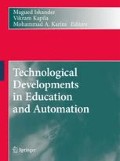Abstract
A robotics-based freshman immigration course into Computer Systems Engineering (CSE) was created to introduce students to the main design issues in CSE: multi-controller programming, sensor interfacing, servo actuation and serial communications. The instructional materials were designed around 3 projects: car bot in maze, GERWALK bot penalty kick, and GERWALK bot going up stair steps. Selected descriptive and prescriptive creativity tools were also incorporated into the curriculum to round out student design experience. Mid-term course assessment results are presented in this article.
Access this chapter
Tax calculation will be finalised at checkout
Purchases are for personal use only
Preview
Unable to display preview. Download preview PDF.
References
S. Yost, M. Krishnan, and M. Paulik, "Development of an Integrated Spiral Curriculum in Electrical and Computer Engineering", ASEE Technical Paper No. AC 2008-210, presented at the ASEE Annual Conference in Pittsburgh, Pennsylvania, June 22-25, 2008.
A. O'Fallon, J. R. Hagemeister, C. Cole, and J. Harris, "Increasing Student Retention and Comprehension by Providing Every Student Their Own Industry Standard Tools in Introductory Classes", ASEE Technical Paper No. AC 2008-2335, presented at the ASEE Annual Conference in Pittsburgh, Pennsylvania, June 22-25, 2008.
M. Mataric, J. Fasola, and D. Feil-Seifer, "Robotics as a Tool for Immersive, Hands-On Freshmen Engineering Instruction", ASEE Technical Paper No. AC 2008-139, presented at the ASEE Annual Conference in Pittsburgh, Pennsylvania, June 22-25, 2008.
C. N. Thai, “A Dual-Mode/Dual-Workspace Classroom Environment", ASEE Technical Paper No. AC 2008-257, presented at the ASEE Annual Conference in Pittsburgh, Pennsylvania, June 22-25, 2008.
R. Root-Bernstein and M. Root-Bernstein, Sparks of Genius. New York, NY: Mariner Books, Houghton Mifflin Co., 1999, pp. 182-201.
B. Eberle, Scamper: Creative Games and Activities for Imagination Development. Waco, TX: Prufrock Press, 1997.
S. Kaplan, Inventive Problem Solving - Critical Thinking for Problem Solving Using TRIZ. Fort Wayne, IN: Aptimise, 2008.
Robotis, Bioloid User's Guide, V 1.1. Bucheon City, Republic of Korea: Robotis Co., LTD., 2007.
Robotis, Bioloid Quickstart (Comprehensive), V 1.1. Bucheon City, Republic of Korea: Robotis Co., LTD., 2007.
K. Bain, What the Best College Teachers Do. Cambridge, MA: Harvard University Press, 2004.
E. Raudsepp, “How Creative are You?”, in Creativity, edited by A. D. Timpe, Ed. New York, NY: Facts on File Publications, 1987, pp. 34-38.
J. G. Gillis, “Creativity, Problem Solving and Decision Making”, in Creativity, edited by A. D. Timpe, Ed. New York, NY: Facts on File Publications, 1987, pp. 209-213.
R. L. Martin, The Opposable Mind. Boston, MA: Harvard Business School Press, 2007.
V. Fey and E. Rivin, Innovation on Demand: New Product Development Using TRIZ. Cambridge, UK: Cambridge University Press, 2005.
S. D. Savransky, Engineering of Creativity: Introduction to TRIZ Methodology of Inventive Problem Solving. Boca Raton: FL: CRC Press, 2000.
Author information
Authors and Affiliations
Corresponding author
Editor information
Editors and Affiliations
Rights and permissions
Copyright information
© 2010 Springer Science+Business Media B.V.
About this paper
Cite this paper
Thai, C.N., Mativo, J.M., Clinton, G. (2010). Robotics-based Curriculum Development for An Immigration Course into Computer Systems Engineering. In: Iskander, M., Kapila, V., Karim, M. (eds) Technological Developments in Education and Automation. Springer, Dordrecht. https://doi.org/10.1007/978-90-481-3656-8_32
Download citation
DOI: https://doi.org/10.1007/978-90-481-3656-8_32
Published:
Publisher Name: Springer, Dordrecht
Print ISBN: 978-90-481-3655-1
Online ISBN: 978-90-481-3656-8
eBook Packages: Humanities, Social Sciences and LawEducation (R0)

